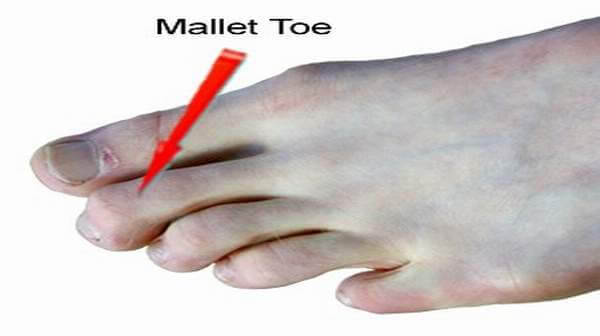What's in this article?
It is similar to hammertoe; in both conditions, the toe bends downward, causing it to resemble a mallet or hammer. A mallet toe occurs when the joint at the end of the toe cannot straighten. Excessive rubbing of the mallet toe against the top of the shoe can lead to pain and the development of a corn. The tip of the toe is often turned down against the shoe causing pressure and discomfort.
Causes of Mallet Toes?
Mallet toe can result from the following:
- Injury to the toe.
- Shoes that are too tight.
- Bone and muscle imbalances.
- Arthritis.
Symptoms of Mallet Toes
Symptoms of mallet toe may include:
- Pain in the toe, often with movement of the foot
- Stiffness
- Corns and calluses
- Toe stuck in a bent position, forming the shape of a mallet
The deformity may be fixed or flexible. If you have flexible mallet toe, you may be able to straighten your toe.
If you have fixed mallet toe, however, you may not be able to move the toe at all. Pressure on the bent surface of the toe joint can cause irritation. Over time, a corn may develop on the top of the toe, and callus can form on the bottom of the toe.
Corns and calluses can become painful and cause additional symptoms, such as redness, bleeding, and difficulty wearing socks and shoes.
Treatment and Prevention
Any forefoot problems that cause pain or discomfort should be given prompt attention. Ignoring the symptoms can aggravate the condition and lead to a breakdown of tissue, or possibly even infection. Conservative treatment of mallet toes begins with accommodating the deformity. The goal is to relieve pressure, reduce friction, and transfer forces from the sensitive areas. Shoes with a high and broad toe box (toe area) are recommended for people suffering from forefoot deformities such as mallet toes. This prevents further irritation in the toe area from developing. Other conservative treatment includes forefoot supports such as gel toe caps, gel toe shields and toe crests. Gel forefoot supports provide immediate comfort and relief from common forefoot disorders without drying the skin.
What are the risks of Treatment?
Risks include nerve injury, infection, and stiffness. Recurrence of the toe deformity can occur, especially if you return to wearing ill-fitting shoes.
How to Prevent Mallet Toes
The best thing you can do to prevent mallet toe is to wear shoes that fit well. Many foot problems can be prevented by simply practicing good foot hygiene. To keep your feet and toes healthy:
- Wear comfortable shoes that fit properly, and avoid shoes that are too narrow
- Wear shoes that are appropriate for your type of work and the sports you participate in
- Examine your feet and toes regularly for any skin changes or deformities
- See your podiatrist if you have foot or toe pain
- Do stretching exercises daily to strengthen the muscles in your feet
Mallet Toes Look Like










Leave a Comment